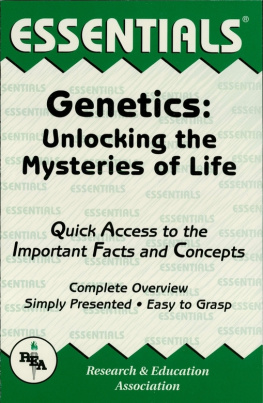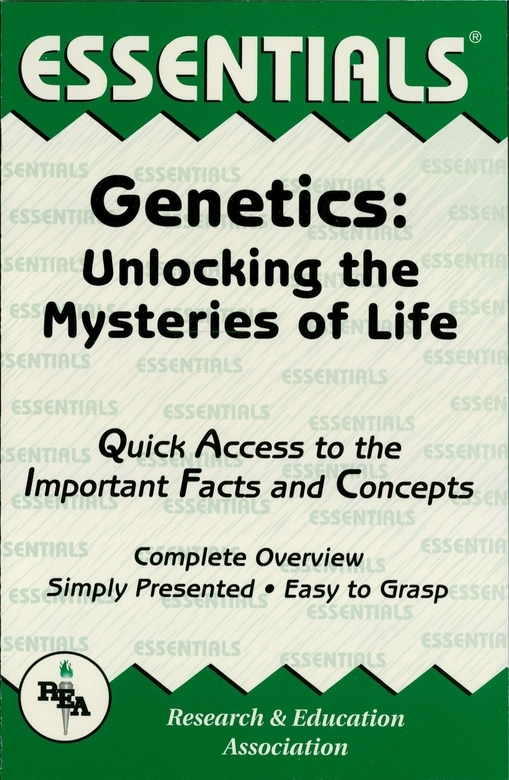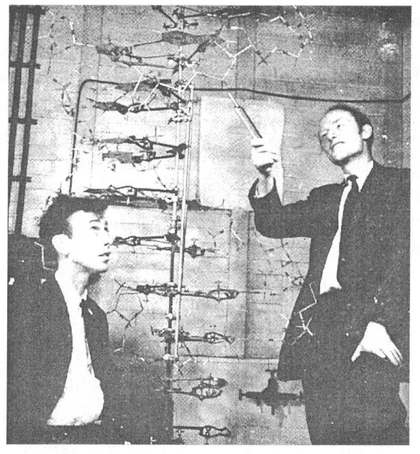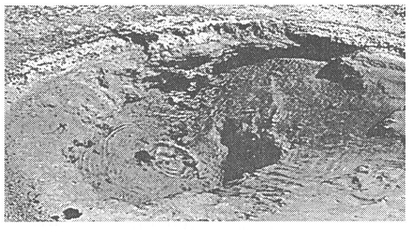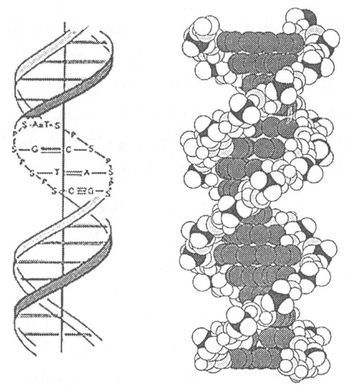Searching for Secrets
Human ingenuity, science, and technology have combined to discover the mechanisms by which life works. They have produced techniques through which diseases can be treated or prevented. These techniques also give scientists the power to alter and redesign living organisms, giving rise to legal and ethical questions on how this power should be used. In searching for the secret of life we need to begin by obtaining answers to the following questions:
- What is the difference between living and nonliving things?
- How does life exist in all its varieties in many different kinds of environmental conditions?
- How are the instructions, vital for making an organism, passed on from one generation to the next?
The answer to all of the preceding questions may be found in DNA.
DNA, which stands for deoxyribonucleic acid, is a long, thin, threadlike material. The length of DNA found in one human being is 200 times greater than the distance from the earth to the sun. DNA is a remarkable molecule. It contains the blueprint for life.
James Watson and Francis Crick, in the early 1950s, discovered how DNA is able to do this. DNA has the shape of a double helix and is composed of a carbohydrate backbone. Inside the grooves of the double helix, extending from the carbohydrate backbone, are molecules called nucleotides or bases that are designated by the initials A, G, T, or C.
The Watson & Crick model of DNA, the blueprint for life.
All information and instructions for life contained in DNA are written in a code consisting of these four molecules. A single instruction is encoded by a piece of DNA called a gene, some of which may be thousands of letters long. The instructions needed to specify an entire human being are six billion code letters long. Every cell, in its nucleus, contains all the information needed to produce a human being. This information is contained in many long strands of DNA, which themselves are separated into chromosomes. The DNA of a human is found in 23 pairs of chromosomes. Every organism that is living, or has lived, contains DNA which spells out that organisms specific instructions for life.
Early life is thought to have originated in an environment similar to the Sulfatar Crater in Italy.
Life at the Beginning
Charles Darwin believed that life originated in a warm pond. Today, however, biologist Karl Stetter believes that life originated in an environment similar to that of the sulfurous ponds in Sulfatar Crater near Naples, Italy, where the temperature is very hot (96C) and there is little oxygen available. Stetter believes it was under these conditions that the proper ingredients came together to make life possible.
DNA was not present in the early earth environment, but Stetter believes when organisms were first formed they had DNA. Stetter studies the conditions of primitive earth by simulating them in giant fermentation vessels in his laboratory in Regensburg, Germany. Until recently, many scientists did not believe that life could exist in such an environment; however, Stetter has discovered many species of bacteria that can live in these conditions. Not only can these bacteria live at very high temperatures, they can utilize sulfur for energy and do so in the absence of oxygen.
These species of bacteria are thought to be living descendants of an ancestral form of life. Contained within these bacteria are the DNA instructions for surviving in such a primitive earthlike environment, the same DNA instructions used by the ancestral form of life to survive in similar conditions.
Because of its unique double helical structure, DNA has the ability to pass on its instructions to the next generation. The DNA double helix can unwind and each strand be used as a model to copy the instructions. In this way DNA can pass its information from generation to generation. While extinction of an organism will obviously stop this process, this does not mean the DNA from these organisms cannot be studied.
Amber, a material found in pine resin, can preserve small organisms such as insects. Some of these preserved samples may be as much as 25 to 100 million years old. These ancient insects are used by entomologists to make comparisons between ancient and modern insects. Entomologists theorized that if tissue survived in these preserved specimens intact DNA could be isolated.
Ancient DNA
The DNA instructions from these ancient specimens could contribute to the knowledge of insect evolution. The preserved DNA can be extracted, amplified, and analyzed using laboratory techniques. The order of the four bases which make up the DNA is then determined by sequencing the DNA. By using these methods, scientists can determine the instructions encoded in the DNA of extinct insects. By examining the genetic code of these and other organisms, scientists can gain insight into how extinct organisms lived and evolved into their modern forms. DNA contains the instructions for making an organism, therefore, by studying the DNA, scientists are studying the organism.
A DNA chain contains the genetic codes for life.
It is possible that if the entire DNA sequence was known for an organism, that organism could be wholly reconstructed. This is the premise used for the movie Jurassic Park and realized to a smaller extent in the laboratory. For instance, a blood-sucking insect, which has been extinct for 70 to 80 million years, may contain blood cells from its most recent meal, perhaps a dinosaur. These dinosaur cells could contain intact DNA which could be analyzed and sequenced. However, in order to recreate a dinosaur, all of the DNA must be preserved intact. This possibility is minuscule.
DNAOur Personal Blueprint
All the DNA found in human cells is referred to as the human genome. Presently, the human genome is being sequenced and decoded in laboratories around the world as part of ongoing multibillion dollar projects to read the entire six billion letter codes of human DNA. DNA is made up of genes which are individual sets of instructions encoding for such diverse features as hair color to the structure of enzymes found in the digestive system. Genes encode all the information required to put together the parts making up an organism.
There are 100,000 human genes in the human genome. There are approximately 2500 human genes known. Therefore, almost 98% of the genes have not yet been discovered. Discovering this information is the goal of many scientists. At the National Institutes of Health in Bethesda, Maryland, Craig Venter and his team of scientists are studying the genes that comprise the DNA of the human brain.
Dr. Venter believes there may be as many as 30,000 genes expressed exclusively in the brain and many of these may be important in the specific functions of the brain. This represents approximately one-third of the entire human genome. These genes are involved in personality, brain processes, and general brain function. Humans are defined by these processes. Scientists believe that by studying these genes they are finding the answers to questions about human life. The brain is at the center of that which makes us human, so studying the brain may lead to a better understanding of ourselves.

